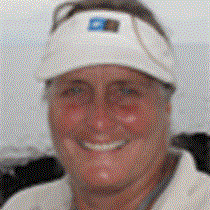Northern Isabela & Fernandina Islands
I gave an optional early wake up call this morning to encourage our guests to come topside with us and help search for marine mammals. We had wonderful conditions: some clouds, some sun, a calm ocean, and a cool breeze. But for 45 minutes all we observed were dozens of fur seals porpoising towards shore after a night feeding at sea and soaring sea birds. Noddy terns, wedge-rumped storm petrels, Galápagos shearwaters and the once endangered dark-rumped petrels were plentiful and we were glad to identify them, but we were also searching for whales and/or dolphins!
Finally, at 0715 Naturalist Gaby who was on lookout from the sky deck sang out “whale spout ahead!” For the next twenty minutes we had great looks at a feeding mother Bryde’s whale and her large calf. They spouted and dove, showing their long gray backs and small curved dorsal fins. The first officer returned National Geographic Islander to her course towards the equator line, and we headed down to the breakfast buffet feeling satisfied and content. We realize it is a privilege to have seen these beautiful cetaceans peacefully feeding unthreatened in this large and marvelous marine reserve.
We crossed the equator line with fanfare and a count down, and soon dropped anchor off the dramatic cliffs of Volcan Ecuador at Punta Vicente. We boarded the Zodiacs for a ride along the coast and found many terrestrial and marine species. Blue-footed boobies plummeted from the sky around us, feeding on tightly schooling black striped salema. Penguins and turtles surfaced near the boats and we spotted resting fur seals, wing-drying cormorants and huge courting male iguanas surrounded by groups of smaller females along the shore. Out to sea we located several huge Mola molas – pelagic sunfish – and were able to see these 6 foot in diameter, gray and white spotted fish near the surface of the ocean.
Patricia Zarate, a scientist from the Charles Darwin Research Station was with me and my group in the last Zodiac to depart the ship. She and I were perfecting a protocol to census sea turtles along a transect line during our Zodiac ride. The guests were eager to assist us and between admiring penguins that came right up to inspect the boat and learning about the breeding system of the marine iguanas, we counted all the sea turtles that we could see. In just under a half hour, along the transect we agreed to, we counted 36 sea turtles! Patty has been researching turtles in Galápagos for the past seven years, and she is excited that we will be able to contribute important data gathered weekly by our naturalists from the National Geographic Islander. We can count turtles at Punta Vicente every Wednesday and obtain information on how the numbers of turtles here vary over the year.
Following the Zodiac ride, we took 35 of our more adventuresome guests snorkeling in the churning and turbulent cool waters. We were delighted to swim among dozens of sea turtles and even had penguins flitting under us chasing tiny bait fish. This is an important feeding site for sea turtles so Patty and I counted the turtles underwater, too. She was surprised to see many males (which are usually difficult to find in Galápagos) and juveniles, and she noted that none of the individuals we looked at closely were reproductive animals. Guest Kevin Noori, a young man who aspires to be a marine biologist, stuck with Patty and me for an hour in the cold water as we inspected and recorded turtles.
Back on board we indulged in a hearty lunch, and a short but welcome siesta, and at 1530 we disembarked at Punta Espinosa, Fernandina Island. Blue-footed boobies were in a feeding frenzy as we motored to shore. We landed on the barren lava and were immediately entranced by the countless marine critters exposed in the tidal pools. The afternoon walk was absolutely fabulous! There were hoards of marine iguanas, flightless cormorants courting, sunning and nesting, a juvenile hawk, bright red sally light foot crabs creeping along the jet black lava, and we even spotted a Galápagos snake searching the cracks for lizards or hatchling iguanas.
Call +1.800.397.3348 or contact your travel advisor



